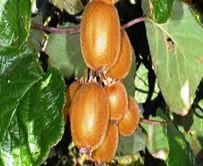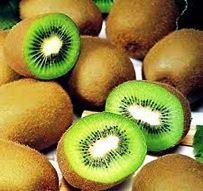Multitherapeutic values of Kiwifruit
Multitherapeutic values of Kiwifruit
 The kiwifruit, often shortened to kiwi in many parts of the world, is the edible berry of a woody vine in the genus Actinidia. The most common cultivar group of kiwifruit ('Hayward') is oval, about the size of a large hen's egg (5–8 cm in length and 4.5–5.5 cm in diameter). It has a fibrous, dull greenish -brown skin and bright green or golden flesh with rows of tiny, black, edible seeds. The fruit has a soft texture and a sweet but unique flavor, and today is a commercial crop in several countries, such as Italy, New Zealand, Chile, Greece and France. Kiwifruit is native to southern China where it has been declared a National Fruit of China. Other species of Actinidia are native to India, Japan, and southeastern Siberia. The seeds were planted in 1906 by a Wanganui nurseryman, Alexander Allison, with the vines first fruiting in 1910. New Zealanders discarded the local Chinese name for the fruit (yáng táo[a]) in favor of the name Chinese Gooseberry. After World War II it was marketed under the name "Melonette".
The kiwifruit, often shortened to kiwi in many parts of the world, is the edible berry of a woody vine in the genus Actinidia. The most common cultivar group of kiwifruit ('Hayward') is oval, about the size of a large hen's egg (5–8 cm in length and 4.5–5.5 cm in diameter). It has a fibrous, dull greenish -brown skin and bright green or golden flesh with rows of tiny, black, edible seeds. The fruit has a soft texture and a sweet but unique flavor, and today is a commercial crop in several countries, such as Italy, New Zealand, Chile, Greece and France. Kiwifruit is native to southern China where it has been declared a National Fruit of China. Other species of Actinidia are native to India, Japan, and southeastern Siberia. The seeds were planted in 1906 by a Wanganui nurseryman, Alexander Allison, with the vines first fruiting in 1910. New Zealanders discarded the local Chinese name for the fruit (yáng táo[a]) in favor of the name Chinese Gooseberry. After World War II it was marketed under the name "Melonette".
Cultivars
The genus Actinidia contains around 60 species. Though most kiwifruit are easily recognized as kiwifruit (due to basic shape) their fruit is quite variable. The skin of the fruit can vary in size, shape, hairiness, and color. The flesh can also vary in color, juiciness, texture, and taste. Some fruits are unpalatable while others taste considerably better than the majority of the commercial varieties. The most common kiwifruit is the Fuzzy Kiwifruit and comes from the species A. deliciosa. Other species have fruits that are commonly eaten; some examples are: Golden Kiwifruit (A. chinensis), Chinese Egg Gooseberry (A. coriacea), Baby Kiwifruit (A. arguta), Arctic Kiwifruit (A. kolomikta), Red Kiwifruit (A. melanandra), Silver Vine (A. polygama), Purple Kiwifruit (A. purpurea).
Cultivation
 Kiwifruit can be grown in most temperate climates with adequate summer heat. Where fuzzy kiwis (A. deliciosa) are not hardy, other species can be grown as substitutes. Kiwifruit is commercially grown on sturdy support structures, as it can produce several tonnes per hectare, more than the rather weak vines can support. These are generally equipped with a watering system for irrigation and frost protection in the spring. Kiwifruit vines require vigorous pruning, similar to that of grapevines. Fruit is borne on one-year-old and older canes, but production declines as each cane ages. Canes should be pruned off and replaced after their third year.
Kiwifruit can be grown in most temperate climates with adequate summer heat. Where fuzzy kiwis (A. deliciosa) are not hardy, other species can be grown as substitutes. Kiwifruit is commercially grown on sturdy support structures, as it can produce several tonnes per hectare, more than the rather weak vines can support. These are generally equipped with a watering system for irrigation and frost protection in the spring. Kiwifruit vines require vigorous pruning, similar to that of grapevines. Fruit is borne on one-year-old and older canes, but production declines as each cane ages. Canes should be pruned off and replaced after their third year.
Health benefits of Kiwifruit
Kiwifruit is the most nutrient-rich of the top 26 fruits consumed in the world today. It also has the highest density of any fruit for vitamin C and magnesium limited mineral in the food supply of most affluent countries and a nutrient important for cardiovascular health. Among the top three low-sodium, high-potassium fruits, kiwifruit ranks number one, having more potassium than a banana or citrus fruits.
Cancer
- Kiwifruit has been shown to contain an anti-mutagenic component, helping to prevent the mutations of genes that may initiate the cancer process. The presence of glutathione may account for the reduction. Carcinogenic nitrates are formed during the smoking or barbecuing of foods. When nitrates are ingested, a process called nitrosation can occur, in which free radicals 'nitrosamines' are formed that may lead to the formation of gastric or other cancers. Kiwi has been demonstrated to aid in the prevention of nitrosation.
- In another in vitro test with cultured mammalian-cell lines, kiwifruit extract was found to inhibit melanoma, or skin cancer. The amino acid arginine, present in kiwifruit, is being looked at by cardiologists to improve post angioplasty blood flow and actually prevent the formation (or reformation) of plaque in the arteries. Kiwifruit is ranked as having the fourth highest natural antioxidant potential next to the red fruits containing high levels of beta carotene.
- Lutein, an important phytochemical found in kiwifruit, has been linked to the prevention of prostate and lung cancer. In addition to kiwifruit being recognized by the FDA as an excellent source of dietary fiber, studies indicate that it contains another not-yet-isolated compound that accelerates digestive transit time even faster than dietary fiber alone - important for colorectal cancer prevention. The benefit of this laxative action is to decrease the build-up of cancer-promoting metabolites. Kiwifruit is one of the few fruits that are green at maturity, and chlorophyll is responsible for that color. Several studies have suggested that chlorophyllin, a derivative of chlorophyll, is an inhibitor of liver carcinogenesis.
Depression
Inositol is found in kiwifruit. Recent studies have shown that inositol, because of its function as a precursor of an intracellular second messenger system, can be beneficial in the treatment of depression.
Diabetes
Inositol, a sugar alcohol naturally occurring in kiwifruit, may play a positive role in regulating diabetes. Inositol supplements may improve nerve conduction velocity in diabetic neuropathy. Inositol plays a role in intracellular responses to hormones and neurotransmitters. It acts as a second messenger in cell signaling processes.
Eye health/Macular degeneration
Kiwifruit contains a wealth of carotenoids (beta carotenes, luteins and xanthophylls); phenolic compounds (flavonoids and anthocyanins) and antioxidants, including vitamins C and E. The excellent complement of antioxidants in kiwifruit may help prevent the oxidation of the good cholesterol (HDLs). Kiwifruit is particularly high in two amino acids: arginine and glutamate. Arginine may help promote an increase in arteriolar dilation, working as a vasodilator and improving blood flow that is important for heart health. The FDA considers kiwifruit a good source of vitamin E, crucial for a healthy heart. Kiwifruit contains magnesium at 6% DV. Magnesium is thought to be in short supply in the diets of affluent countries. Poor magnesium status is associated with heart disease, myocardial infarction and hypertension. Kiwifruit contains pectin, which has been shown to lower cholesterol.
Hypertension
Cardiologists believe the sodium-to-potassium ratio is critical for heart health. That ratio is extremely favorable in kiwifruit.
Immunity
Kiwifruit has been shown to be an immune booster, most likely due to its extremely high vitamin C content and its complement of antioxidant compounds.
Impotence
Kiwifruit contains the amino acid arginine, a well-known vasodilator that has been used to treat impotence in men.
Physical Fitness
Kiwifruit contains a wide range of minerals (electrolytes) essential for replenishing those lost during exercise especially in hot environments. It is also a naturally significant source of electrolytes for a pre-workout regimen. In China, a kiwi-based sport drink was designed to overcome athletic training in a hot environment, where large amounts of minerals can be lost in sweat. A 5% addition of carbohydrates to the kiwifruit juice helped to maintain a normal glucose level during exhaustive training.
Stress Reduction
Kiwifruit contains a relatively high level of serotonin. Serotonin causes a calming effect in most individuals
Weight Control
Calorie for calorie, kiwifruit is one of the most nutrient-rich fruits. You get the best balance of nutrients per calorie (the most nutrients for the fewest calories) from kiwifruit, cantaloupe, papaya and lemons.
Source: Dr Vikram Sharma, Email-drvsharma99@gmail.com
Last Modified : 6/28/2024
This topic deals with information related to Tobac...
Provides information about World Cancer Day - Febr...
Types of cancers, symptoms, screening methods are ...
Provides information related to the National Centr...
